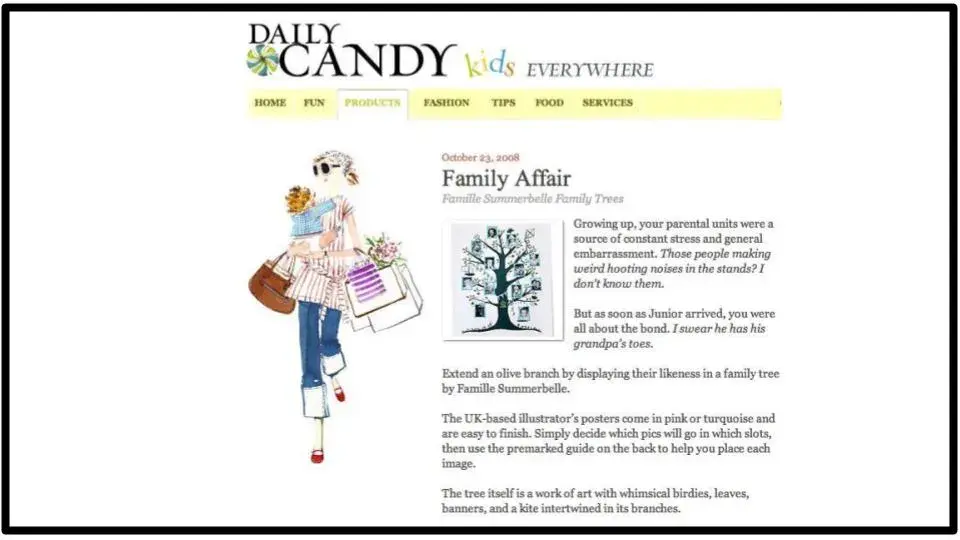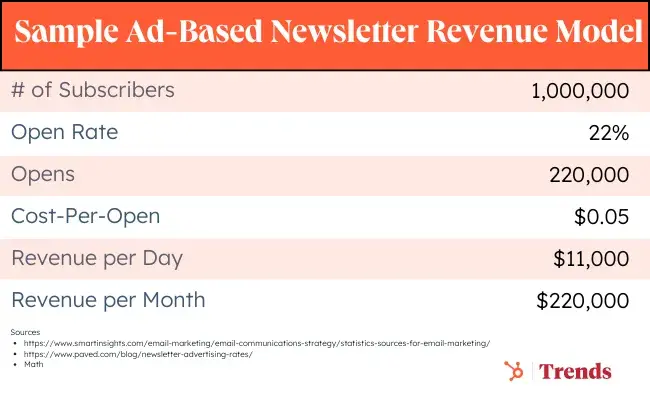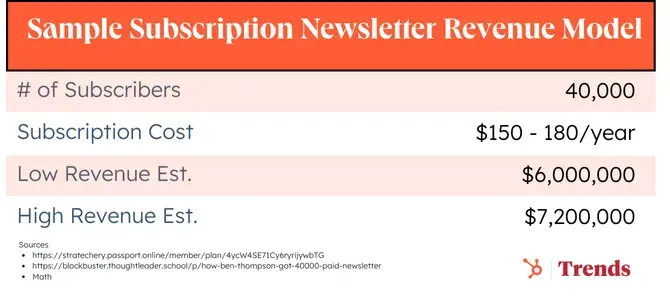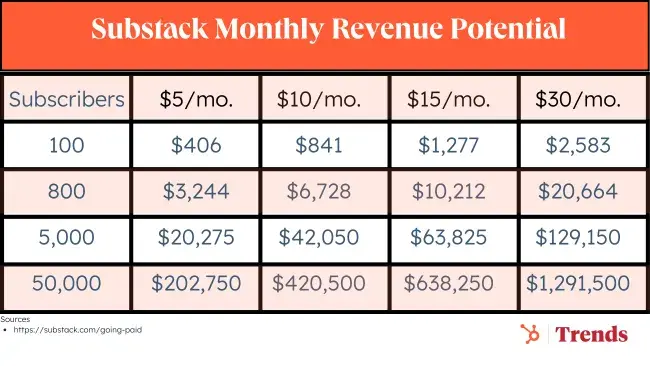Our view at Stack - Simplify growth with an all-in-one platform. Powerful marketing, sales, and support automation. Integrated CMS. Scalable software. Crafted for customer experience.
Welcome to Trends, a weekly newsletter with the zestiest business trends and actionable insights for entrepreneurs.
Summary
- Great Margins: Newsletters are a simple yet profitable business (e.g., Ben Thompson’s Stratechery is estimated to gross between $6-7m.)
- Ads or Subs: Core newsletter business models include ad-supported (The Skimm, Morning Brew) and subscription-based (Stratechery, 2PM)
- Newsletter Media Firms Hitting 9-Figure Valuation: Notable media companies built through newsletter have hit multi-million dollar valuations. (The Athletic was acquired by the NYT for $550m.)
- Multiple Business Lines: Media firms that begin as a newsletter can extend into other offerings (e.g., premium research, e-commerce, community forums, networking tools, podcasts)
- Secret Sauce: Newsletters have a number of strengths vs. traditional media including a direct relationship with end users, higher engagement, and lean operating costs
- What’s Next: Opportunities include B2B content niches and tools that provide curation (bundling) or paywall services

Bob Pittman—the creator of MTV, former CEO of Six Flags, Time Warner, AOL, and Century 21 Real Estate, and now current CEO of iHeartMedia—has had a hell of a career.
With an incredible background in the media business, Pittman turned heads in 2003 when he launched Pilot Group. The new venture was an incubator and investment fund for a business that many people wouldn’t have expected a media tycoon to get involved in: newsletters.
Trends readers have long expressed an interest in the nuts and bolts behind the newsletter business. This report will give you a behind-the-scenes look at how it works.
And in doing so, we’ll answer why Pittman (along with thousands of other entrepreneurs) have flocked to this simple, but surprisingly profitable business model.
Table of Contents
- A Brief History of Newsletters and Profit
- Which Newsletter Business Model Should You Choose?
- 7 Reasons to Jump Into Newsletter Marketing
- 5 Challenges with Running Newsletters
- Newsletter Niche Opportunities
- Newsletter Examples to Learn From
A Brief History of Newsletters and Profit
In 1996, Microsoft released Internet Mail and News 1.0, a feature for its Internet Explorer browser. This was later renamed Outlook.
That same year, other companies like Hotmail started offering free email services that could be used anywhere. And email was born.
Since then, email has become embedded in our culture. (The number of email users topped 4 billion globally in 2023, according to the research firm The Radicati Group.)
In those early years, companies primarily used email as a way to send marketing material.
However, when Pittman entered the industry, he changed the perception of email. Specifically, he showed that email newsletters can be a standalone business.
Pittman & The Pilot Group
In December of 2003, Bob Pittman acquired DailyCandy, a trendy daily email for young women that featured tips on everything from restaurants and nightclubs to sample sales and beauty finds.
Pittman paid $3.5m for the business. At the time, DailyCandy consisted of 200k subscribers and a brilliant editor/founder named Danielle Levy.
The plan behind Pittman’s investment, say sources familiar with his strategy, was to help transform DailyCandy from a newsletter into a multimedia player that could extend its brand into magazines and books, stand-alone television shows, and perhaps even shopping or restaurant guides.

A screenshot of the DailyCandy website from 2008
Over the next 5 years, DailyCandy went all-in on email.
By 2009 the company grew to 2.5m subscribers and, according to Pittman, $25m in revenue with EBITDA of over $10m. That same year, Comcast acquired DailyCandy for $125m.
Following the acquisition, Pittman launched The Pilot Group, an incubator dedicated to launching DailyCandy for other verticals.
Pilot’s companies included Thrillist (now a $500m media company), PureWow ($25m in revenue before it was acquired for $40m), Business Insider (sold for $500m), and dozens more.
Most recently, individuals such as Ben Thompson (Stratechery) and Bill Bishop (Sinocism) have proven that single-person newsletter operations can generate 7-figures in annual revenue.
Furthermore, in recent years media companies built through newsletters have been generating healthy 8 figures in revenue:
- The Skimm: $30m
- Industry Dive: $29m
- Axios: $25m
A salient example of the growing trend in newsletters is the rise of Substack. The startup provides tools for writers to write, distribute, build community and monetize newsletters. Since 2017, Substack has raised a total of $90.2m from investors like Y Combinator and Andreessen Horowitz.
The platform boasts 17k paid writers, with the top 10 collectively generating $25m annually.
Which Newsletter Business Model Should You Choose?
Warren Buffet famously loved newspapers. They were predictable and profitable.
In their place, newsletters have stepped in, with all the upside (low cost, direct-to-consumer benefits, an opportunity to find many profitable niches) and little of the downside.
There are two primary business models in the newsletter business: ad-supported and subscription-based.
Ad-Supported (Examples: Morning Brew, The Skimm, Axios)
For ad-supported newsletters, the key metrics include:
- Subscribers
- Sends
- Cost per mille (CPM): Advertising rate based on 1k (subscribers or emails sent.)
- Open rate: percentage of emails opened by a unique subscriber.
- Cost per open (CPO): Advertising rate based on the number of unique opens.
- Cost per click (CPC): Advertising rate based on the number of clicks.
- Click through rate (CTR): Number of clicks advertisers receive on their ads per number of impressions
And key ad types include:
- Sponsored Ads: Basic advertising placement. (standard copy from advertiser or copy written in the voice of the newsletter)
- Advertorial: Advertisement that is formatted like an editorial. (Be cautious with this. Trust is easy to lose and hard to win back.)
- Takeover: An ad campaign that takes over a large segment (or entirety) of a newsletter.
The sample ad-based model below looks at the monthly revenue for a newsletter sent five days a week with the following assumptions:
- Number of Subscribers: 1m
- Open Rate: 22% (Avgerage open rate for a 5 sends/wk newsletter per Smart Insights.)
- Cost-per-open: $0.05 (Average CPO per research by Paved newsletter platform.)
Based on these assumptions, the monthly ad revenue for this fictional average newsletter is $11k per day or $220k per month (5 sends per week.)

Subscription-Based (Examples: Stratechery, The Athletic, 2PM)
Self-Published Model:
A DIY subscription-based newsletter typically works in the following manner:
- A writer or team of writers provides content related to a specific niche in exchange for a monthly or yearly (discounted) subscription fee.
- The writer will mail said content on a consistent schedule (e.g., every Monday and Thursday).
- To attract new subscribers, the team will make X% of content free and paywall the remaining content
Stratechery, written by Ben Thompson, is a tech and business strategy newsletter launched in 2013. Thompson provides one free weekly article and three additional pay-walled reports per week.
While Stratechery has not confirmed subscriber count in a number of years, Michael Simmons of Blockbuster Blueprint estimated it around 40k in late 2023. Simmons doesn’t offer a source, but in 2020 internet sleuths pinned Thompson’s paying subscribers at a minimum of 25k, so 40k seems like a reasonable growth rate for 3 years.
As of now, subscription options stand at $150 annually or $15/mo. ($180 per year.)
If we can abuse statistics for a moment by ignoring factors like churn rate and subscriber retainment …ahem … based on this fairly rough guesstimate, Thompson brings in a gross profit somewhere between $6 – 7.2m per year.

Substack Subscription-Based (Examples: Petition, TrueHoop)
Another option for a subscription-based newsletter is Substack.
With the self-published model, every aspect of the business falls to the author or editorial team. To successfully operate a newsletter business, an entrepreneur needs to be familiar with a whole host of tools and processes—membership software, forums, payments, content delivery networks, hosting, etc.
Substack has created a platform that offers a turnkey solution for these back-end services for creators (thus, allowing them to focus on content creation):
- For newsletters with paid subscriptions, Substack takes a 10% cut of subscription revenue.
- With additional payments (e.g., transaction fees), the Substack revenue calculator shows an ~80% profit margin for creators.

For those wondering “when is it a good time to monetize“, Substack has a great article based on the platform’s data (Your Guide To Going Paid). The article is well worth reading but here are some notable bullet points:
- Start with a revenue target that feels right to you. Remember to adjust for income tax, as well as Substack’s and Stripe’s fees (10% + 2.9% plus 30 cents per transaction, respectively).
- Estimate your number of paying subscribers, based on the size of your free list. We commonly see conversion rates of 5–10%.
- Divide your revenue target by your number of paying subscribers to get to your annual price, then work backwards to a monthly price.
- We often see writers charge $5/month for newsletters in the personal interest category and $10/month for those in a business category, but challenge yourself to charge more than you think is possible. Set your price 20% higher than you normally would; you can always offer a 20% discount for your earliest subscribers.
Here are some methods that popular Substackers employ to draw more readers into subscriptions:
- 1:X ratio of free-to-paid posts: Judd Legum of Popular Information publishes four days a week, Monday through Thursday—one free post and three paid posts. The free posts act as a lead magnet.
- Weekly paid posts with free previews: Richard Rushfield of The Ankler writes an insiders’ newsletter about the entertainment industry. He publishes paid posts 1-2x/week with a free preview version. The preview acts as a teaser.
- Private member community: Nadia Bolz-Weber of The Corners publishes occasional free posts (1-2x/month), but only paying subscribers get access to the community— including behind-the-scenes Q&As, community discussion threads, quarterly book clubs, and guest posts.
- Exclusive bonus material: Flow State publishes recommendations for free music to work to every weekday. But they have to find it themselves. Paying subscribers get access to curated Spotify playlists.
And while Substack is the most well-known newsletter platform, it isn’t the only player. Beehiiv has become a new favorite among indie newsletter publishers. Another popular alternative “newsletter-as-a-service” tool is called Ghost. Instead of a transaction fee, Ghost charges a flat monthly rate that starts at as little as $9/mo.
And, of course, there are more traditional mass email-sending platforms that are adding increasingly more newsletter-style functionality. (Mailchimp, Constant Contact, and Marketing Hub come to mind.)
Additional Considerations For DIY Subscription vs. Substack:
While Substack provides a turnkey solution, the platform has a number of notable limitations for those looking to rev up paid subscription businesses:
- The 10% fee is quite steep, especially when annual revenue gets into 7 figures.
- There are limited customization options.
- Newsletter websites typically have to use the _______.substack.com domain, which can stifle branding.
- Substack’s current offering doesn’t allow for additional revenue products (e.g., ecommerce) and their referral program only allows you to gift subscriptions.
7 Reasons to Jump Into Newsletter Marketing
1. The Mass Adoption of Email is Still Growing.
Every few years someone declares email marketing dead. We not-so-humbly disagree.
As mentioned above, there are 4B email users worldwide, as compared to 3.5B social media users. And annual growth in email use is projected at a steady 2-3% over the next three years, bringing more end users into the email universe.
2. Newsletters Have Better Engagement Than Social Media.
In addition to the wide (and still growing) adoption of email, the channel has better engagement than the largest social networks:
- vs. Facebook: Organic reach on Facebook is under 10% while Constant Contact puts the average open rate for overall industry email at 32.55% as of the time of publishing.
- vs. Twitter: Click-through rates on tweets are less than 1% while email’s overall avg. click-to-open rate is 8.62% according to research from GetResponse.
3. You Own Your Distribution and Relationship With Readers
Late last year, the entrepreneur and investor Naval Ravikant tweeted that “building a following on Twitter is building a castle out of sand.”
Large tech platforms such as Facebook, Twitter, Linkedin, and Google are famous for “changing algorithms” that can overturn the fortune of a media business overnight (see: Buzzfeed).
Because email is an open standard, when you build an audience via newsletters, you directly own the relationship with the reader and are not at the whim of an algorithm change.
4. …Which Helps To Control Customer Acquisition Costs
With an owned audience there’s less of a reliance on paying platforms (to get “boosted” on social media news feeds) or trying to please Google (to rank high in searches).
While ad price inflation is finally showing signs of cooling, in 2023 the cost of online advertising rose 4.4% YoY.
5. You Can Build A Community
The direct relationship with the end reader is also the perfect jumping point for building a broader community of like-minded people.
As Jenny Sowyrda, HubSpot’s manager of community strategy and operations puts it:
“If you aren’t building your community, your customers and prospects are already building one somewhere else.”
A newsletter allows you to steer that ship. And it becomes a virtuous cycle, as an engaged community can also generate newsletter subscriptions.
6. Newsletters Provide Upsell, Cross-sell, and Lead-Gen Opportunities
When you own a direct relationship with readers, you can offer additional products through the distribution channel:
- Stratechery offers a paid podcast
- Trapital offers early-stage investing opportunities
- Trends offers gated content like this (how meta
)
7. Email is a Stable Medium
In a time when search engine and social media updates have marketers chewing their fingernails off, newsletters offer a predictable ROI.
And while iOS changes have made tracking email engagement more difficult, email itself is a well-established standard with steady conversion. It has not changed very much since its initial rise in the 90s. Moving forward, there will continue to be innovations in email clients (e.g., Superhuman, Hey), but the underlying standard is stable.
5 Challenges with Running Newsletters
1. You absolutely MUST learn about spam laws.
The rise of increasingly stringent digital privacy laws (GDPR in Europe, CCPA in California, CAN-SPAM in Canada) has forced companies to closely follow anti-spam rules including:
- User permissions
- Honest headlines
- Clear identification for ads
- Opt-out options and more.
2. It can be a very crowded space.
Every major publication has a number of newsletter offerings (e.g., New York Times, Washington Post, WSJ). Further, with the rise of turnkey services like Substack, countless newsletters are being launched every day. The newsletter opportunity is as big as ever, but it’s very important to find the content gaps (more on that below).
3. Consumers are experiencing subscription fatigue.
As more written content goes behind a paywall (not to mention paid audio and video streaming services), there is concern that readers will develop subscription fatigue. In recognition of this issue, some Substack publications are bundling together their offerings so readers only have to make one purchase decision.
4. Search visibility is low.
For subscription-based newsletters, the existence of paywalls means that the content is often hidden from search engine bots crawling the web. As a result, the content doesn’t show up in searches for relevant queries.
5. It’s difficult to go viral.
Another related challenge is that gated content has a harder time going viral, as people are less likely to share items that hit paywalls.
Newsletter Niche Opportunities
The opportunities involved in newslettering don’t just stop at running a newsletter yourself. We’ll start with those editorial opportunities, and jump off from there:
Content Gaps (Particularly B2B)
There are countless content niches that could use a dedicated newsletter.
The B2B space is particularly ripe for disruption and offers high revenue potential as industry insiders will pay top dollar for analytics and insights (aka the “corporate credit card effect”).
As Petition—the Substack bankruptcy newsletter—shows, there is great appetite to give traditionally dry, industry-specific trade publications a more approachable voice.
For inspiration, a Google search of popular trade publications shows dozens of opportunities in niche markets:
- AdWeek (advertising)
- Cranes Today (crane industry)
- Game Industry Report Magazine (gambling)
- Design News (designers)
- Engineering News-Record (construction)
- Architectural Record (architecture)
- Hairdressers Journal International (hairdressers)
- Global Custodian (custody and asset management)
- Coach & Bus Weekly (transportation)
Curation, Bundling & Discovery Tools
As noted by Ben Thompson, whenever an industry goes from scarcity to abundance, there is great value in services that facilitate discovery and curation.
For example, Letterlist allows you to browse and surface newsletters and then subscribe with a single click.
Similarly, Substack’s internal discovery tool ranks the top paid and free publications.
Paywall Services
One of the key decisions for any subscription business is to decide how much free content is made available.
- Freemium: Business Insider offers a lot of free content but also has a premium offering.
- Metered Paywall: The New York Times uses a metering policy whereby you can read X amount of articles before you hit a paywall.
- Hard Paywall: The Financial Times and The Information provide zero free content. You must subscribe to read.
Because of these varying strategies, there is an appetite for digital solutions that can register and subscribe readers as well as predict churn (or other related analytics) for paywalled content.
Piano is one such firm. But, based on the Trends team’s experience with the service, there is clearly an opportunity for a superior offering.
Newsletter Management
There are a ton of tools for newsletter senders, but what about newsletter readers?
Management tools are needed to handle the abundance of newsletter. There are a number of solutions that curate newsletter feeds (Feedly, Feedbin) and newsletter reading apps (Stoop, Slick).
Newsletter Examples to Learn From
Ad-Supported Examples
1. Daily Candy
- Year Founded: 2000
- Key People: Dany Levy
- Theme: Pioneer daily email newsletter providing readers with hip and trendy events in their specific cities (started with NY and grew to dozens of other US cities).
- Notes: Sold in 2009 for $125m (was doing $25m EBITDA) to Comcast. Shut down in 2014.
2. The Skimm
- Year Founded: 2012
- Key People: Danielle Weisberg, Carly Zakin
- Theme: Daily newsletter (7m subscribers) summarizing news in an approachable manner and targeting young female millennial professionals
- Notes: The Skimm has raised ~$30m in venture capital, including from investors such as GV (Google Ventures), Shonda Rhimes, Tyra Banks, and Sara Blakely. Investopedia estimates revenue is $350k per send.
3. Industry Dive
- Year Founded: 2012
- Key People: Sean Griffey, Ryan Willumson, Eli Dickinson
- Theme: Media offering that provides 38 B2B newsletters (e.g., Banking, Biopharma, CFO, CIO, Construction, Education, Transport). In addition to ads, the firm also runs marketing services and a brand studio to help corporates (e.g., IBM) with content marketing initiatives.
- Notes: Industry Dive was acquired by a PE firm in September 2019 for an undisclosed price. At the time, the firm was doing $22m in revenue, and acquisition estimates are in the $60-70m range.
4. Front Office Sports
- Year Founded: 2014
- Key People: Adam White
- Theme: A newsletter providing news and insights at the intersection of sports and business.
- Notes: In October of 2018, the company received an undisclosed investment from PE firm Stein’s. The firm has a number of additional offerings including video, podcast, webinars, and sports-related jobs listings.
5. Axios
- Year Founder: 2016
- Key People: Dan Primack, Jim VandeHei, Mike Allen, Roy Schwartz
- Theme: Media firm with 30+ newsletters covering business, tech and politics— plus podcasts and live events.
- Notes: Axios content is known for punchy, bullet-point summaries of the news. The entire media offering has an estimated revenue of $25-30m.
6. Morning Brew
- Year Founder: 2015
- Key People: Alex Lieberman, Austin Rief
- Theme: Daily email newsletter covering the latest news from Wall St. to Silicon Valley.
- Notes: The Morning Brew has grown to offer 15 niche sub-brands, including Marketing Brew, CFO Brew, Healthcare Brew, and… you get the idea. More brews than your local taphouse.
Subscription-Based
7. Stratechery
- Year Founded: 2013
- Key People: Ben Thompson
- Theme: Leading tech strategy (hence name) newsletter that is considered a pioneer in the space of “individuals can make a living writing newsletters.”
- Price: $15/month or $150/year
- Notes: As noted above, a conservative estimate places the newsletter’s revenue at $6-7m a year.
8. 2PM
- Year Founded: 2013
- Key People: Web Smith
- Theme: Daily newsletter that provides news and analysis on the intersection of business and media.
- Price: $20/month or $200/year
- Notes: A newsletter product that also offers data tools, networking opportunities, and curated expert insights.
9. The Information
- Year Founded: 2013
- Key People: Jessica Lessin
- Price: $599/year for the first year
- Theme: In-depth and exclusive tech stories read widely by the tech and investment community (~20k subscribers).
- Notes: The Information is known for breaking tech-related news stories, producing comprehensive tech company org charts, and cultivating an influential network of tech professionals.
10. Petition
- Year Founded: 2016
- Key People: Anonymous Team
- Theme: Bankruptcy and restructuring newsletter that provides insights in an imminently readable and snarky voice.
- Price: $79/month or $799/year
- Notes: Another 7-figure Substack publication with thousands of legal and finance professional subscribers.
Brand-Backed Examples
11. The Hustle
- Year Founded: 2015
- Key People: Sam Parr, Adam Ryan
- Theme: Daily business and technology newsletter written in a fun and irreverent voice.
- Notes: The Hustle was acquired by HubSpot in 2021 and has since grown to over 2m subscribers.
12. Trapital
- Year Founded: 2018
- Key People: Dan Runcie
- Theme: Business strategy analysis of the hip hop industry.
- Notes: A newsletter and podcast offering that provides the world’s best hip hop industry analysis. Trapital now only offers a free newsletter backed by their investment services.
13. The Athletic
- Year Founded: 2016
- Key People: Alex Mather, Adam Hansmann
- Theme: Sports media that covers professional and college sports teams across North America, with recently expanded international soccer coverage.
- Notes: The Athletic’s goal was to unbundle the sports section from newspapers. They were acquired by The New York Times for $550m in 2022.
![]()
If Hubspot is of interest and you'd like more information, please do make contact or take a look in more detail here.
Credit: Original article published here.
